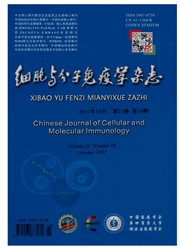

 中文摘要:
中文摘要:
目的探讨辐射损伤导致骨髓造血干/祖细胞(HSC/HPC)衰老的可能机制。方法雄性C57BL/6J小鼠随机分为辐照组和假辐照组,辐照组小鼠经6.5 Gy的X射线全身一次性辐照,假辐照组小鼠处理同辐照组,但不辐照。辐照后24 h免疫磁珠分选法分离并计数两组小鼠的Sca-1+造血干/祖细胞细胞(Sca-1+HSC/HPC),流式细胞术检测细胞周期,β-半乳糖苷酶(SA-β-Gal)染色检测衰老细胞百分率;混合造血祖细胞集落(CFU-Mix)培养观察分选细胞增殖分化能力,单细胞凝胶电泳(SCGE)检测辐照导致细胞的DNA损伤,RT-PCR检测细胞衰老相关基因p16INK4a、p19Arf、p53、p21Cip1/Waf1mRNA的表达;Western blot法检测p16INK4a、p21Cip1/Waf1蛋白表达。结果免疫磁性分析法分离纯度的Sca-1+HSC/HPC可达94%,辐照后小鼠每支股骨的Sca-1+HSC/HPC数量急剧下降,细胞出现G1期阻滞;形成CFU-Mix集落数量和形成集落的细胞数明显降低;SA-β-Gal染色阳性率显著增高,彗星实验显示细胞拖尾明显延长;p16INK4a、p19Arf、p53、p21Cip1/Waf1mRNA表达明显增强,p16INK4a、p21Cip1/Waf1蛋白的表达水平上调。结论辐射导致HSC/HPC DNA的损伤和衰老相关生物学改变,p16INK4a-Rb和p19Arf-p53-p21Cip1/Waf1信号通路可能起一定作用。
 英文摘要:
英文摘要:
Objective To explore the mechanism underlying the aging of hematopoietic stem/progenitor cells (HSC/ HPC) induced by radiation stress. Methods Male C57BL/6J mice were divided randomly into radiation group and control group. The radiation group were treated with total 6.5 Gy X-ray radiation for 24 h; the control group received the same treat- ment except radiation. Thereafter, Sca-] HSC/HPC were isolated by magnetic-activated cell sorting (MACS) from bone marrow of all the mice. The distributions of cell cycle were tested by flow cytometry. The percentage of aging cells was de- tected by SA-I3-Gal staining. The potentials of self-renewal and multi-differentiation were measured by CFU-Mix assay. DNA damages of Sca-1 ~ HSC/HPC were analyzed by single cell gel electrophoresis technique (SCGE). The expressions of se- nescence-associated genes p]6'NK4a, p|9A', p53, [021cipl/waf' mRNA were detected by RT-PCR. Western blotting was per- formed to analyze the expressions of p]6'N~a and p21cipl/waf' proteins. Results The purity of Sca-] ~ HSC/HPC reached 94% after MACS. Compared with control group cells, after radiation, the number of Sca-] ~ HSC/HPC per femur and CFU-Mix sharply decreased ( P 〈 0.05), Sca-1 ~ HSC/HPC apparently showed G! arrest and elevated percentage of SA-13-Gal positive cells (P 〈0.05), cell trailing had a prolonged time, and the expressions of senescence-associated genes (pl6INK4a, pl9A', p53, p21 Cip1/waft ) and relevant proteins ( p16'NK4a, p21Cipl/Waf] ) were up-regulated significantly ( P 〈 0.05 ). Conclusion DNA damage and senescence-associated biological changes of Sca-1 HSC/HPC can be achieved by X-ray radiation, which may be involved in p16NK4a-Rb and p19Art-p53-p21cipl/wafl signal pathways.
 同期刊论文项目
同期刊论文项目
 同项目期刊论文
同项目期刊论文
 Treatment with ginger ameliorates fructose-induced Fatty liver and hypertriglyceridemia in rats: mod
Treatment with ginger ameliorates fructose-induced Fatty liver and hypertriglyceridemia in rats: mod Senescence Effects of Angelica sinensis Polysaccharides on Human Acute Myelogenous Leukemia Stem and
Senescence Effects of Angelica sinensis Polysaccharides on Human Acute Myelogenous Leukemia Stem and 期刊信息
期刊信息
